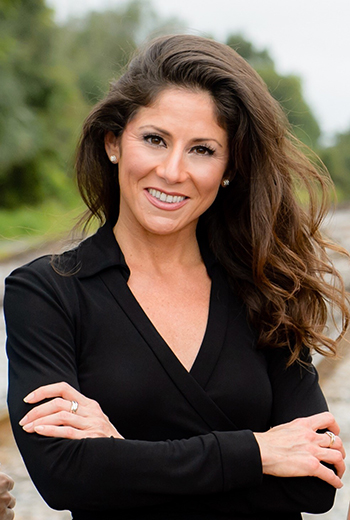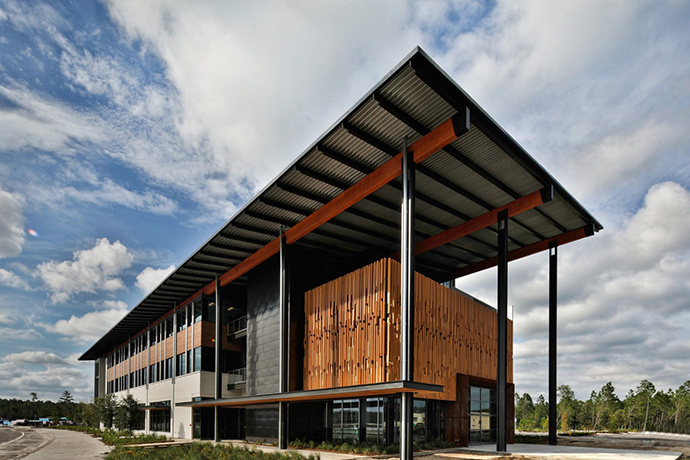The hard work of turning Nassau County in Northeast Florida from a sleepy bedroom and tourist community into a major employment center has begun.
It helps when you land two corporate headquarters projects.
In just the past 12 months, Rayonier Inc. and Florida Public Utilities moved their headquarters to Wildlight, a new mixed-use, master-planned community that upon buildout could have nearly 10,000 residents and 7 million sq. ft. (650,300 sq. m.) of office, industrial and retail space.
By the time the dust settles years from now, what was once little more than a truck stop on Interstate 95 about 30 minutes north of Jacksonville will be transformed into a planned new town and corporate address of choice.
“The entire project is about 2,900 acres [1,174 hectares] with entitlements for 3,200 residential units,” says Charles Adams, vice president of community development for Raydient Places and Properties, the developer of Wildlight. “Our company owns land on both sides of I-95. It has six to seven miles of frontage on I-95, and Wildlight is the first village planned. We are working on a 24,000-acre [9,713-hectare] sector plan. It goes past Highway 17 all the way up to the St. Mary’s River, which is the Florida-Georgia state line.”
Anyone who’s driven down the East Coast on I-95 to Florida has either passed or stopped at the exit for Florida A1A and State Road 200, the main Amelia Island exit off the Interstate. For decades, motorists have given little thought to the immediate surroundings of this interchange — a mostly agricultural and timberland area known as Yulee.
Raydient is changing all that. “The initial planning and entitlement of land began in 2007,” says Adams. “This started when Nassau County and our parent company, Rayonier, requested that the timberland here be developed commercially. The entitlements were agreed to in 2011, and we broke ground in 2016.”

“We are where St. John’s County was 15 years ago. Formerly sleepy rural Nassau County is waking up and getting noticed.”
Since then, Wildlight has seen development of facilities for Rayonier, FPU, University of Florida Health and Wildlight Elementary School, which together form the foundation of Florida’s latest new town.
Rayonier started as Rainier Paper & Pulp in Washington before combining name of the material it became famous for — rayon — and the mountain’s name to become Rayonier in 1937. Two years later, it opened its first cellulose specialties plant in the Southeast right in Nassau County’s Fernandina Beach.
Now, nearly 80 years later, the region is on the cusp of another era of economic growth. Buildout of the 2,900-acre master plan will take 25 years.
“The west side of the county is now opening up for development," says Laura DiBella, executive director and port director for the Nassau County Economic Development Board. "Housing here costs $100,000 less than it does in St. John’s County. New housing, retail, light industrial and headquarters facilities are all coming to Nassau County.”
The first building to go up in Wildlight was the 55,000-sq.-ft. (5,110-sq.-m.) headquarters for Rayonier, which opened in August 2017. FPU followed in January 2018 by announcing that it will construct an 18,000-sq.-ft. (1,672-sq.-m.) building next door. Work on that facility will commence this summer.
“Wildlight’s strategic location within our Florida service territory and commitment to sustainable growth and infrastructure make relocating to this community a natural fit,” said Jeff Householder, president of FPU.
UF Health, meanwhile, is putting up a 46,000-sq.-ft. (4,273-sq.-m.) ambulatory center that will provide urgent care, medical and dental offices, and other healthcare services on site.
Nassau County has 80,622 residents. For the past two decades, most of its growth has occurred around Yulee. “We started doing market research in 2013. Around 380 new homes were built in the county that year,” says Adams. “Around 1,000 new homes were built in 2017. That’s before we started building our homes. Nassau is experiencing quite a bit of growth now.”
Wildlight developers hope that growth includes more corporate employers in the future.
“We are where St. John’s County was 15 years ago,” says DiBella. “Formerly sleepy rural Nassau County is waking up and getting noticed.”

